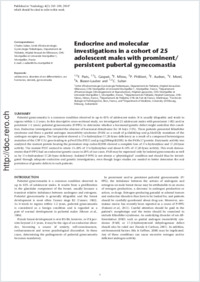Endocrine and molecular investigations in a cohort of 25 adolescent males with prominent/persistent pubertal gynecomastia
- Paris, F. Unité d'Endocrinologie-Gynécologie Pédiatriques, Département de Pédiatrie, Hôpital Arnaud-de-Villeneuve, Montpellier, France - Département d'Hormonologie (Développement et Reproduction), Hôpital Lapeyronie, Montpellier, France
- Gaspari, L. Unité d'Endocrinologie-Gynécologie Pédiatriques, Département de Pédiatrie, Hôpital Arnaud-de-Villeneuve, Montpellier, France - Département de Pédiatrie, Hôpital Caremeau, CHU Nîmes, Nîmes, France
- Mbou, F. Département de Pédiatrie, CHU de Fort de France, Martinique
- Philibert, P. Département d'Hormonologie (Développement et Reproduction), Hôpital Lapeyronie, Montpellier, France
- Audran, F. Département d'Hormonologie (Développement et Reproduction), Hôpital Lapeyronie, Montpellier, France
- Morel, Y. Centre de Biologie et Pathologie Est, Bron, France
- Lauber-Biason, Anna Department of Medicine, University of Fribourg, Fribourg, Switzerland
- Sultan, C.. Unité d'Endocrinologie-Gynécologie Pédiatriques, Département de Pédiatrie, Hôpital Arnaud-de-Villeneuve, Montpellier, France - Département d'Hormonologie (Développement et Reproduction), Hôpital Lapeyronie, Montpellier, France
-
01.03.2016
Published in:
- Andrology. - 2016, vol. 4, no. 2, p. 263–269
English
Pubertal gynecomastia is a common condition observed in up to 65% of adolescent males. It is usually idiopathic and tends to regress within 1–2 years. In this descriptive cross-sectional study, we investigated 25 adolescent males with prominent (>B3) and/or persistent (>2 years) pubertal gynecomastia (P/PPG) to determine whether a hormonal/genetic defect might underline this condition. Endocrine investigation revealed the absence of hormonal disturbance for 18 boys (72%). Three patients presented Klinefelter syndrome and three a partial androgen insensitivity syndrome (PAIS) as a result of p.Ala646Asp and p.Ala45Gly mutations of the androgen receptor gene. The last patient showed a 17α-hydroxylase/17,20-lyase deficiency as a result of a compound heterozygous mutation of the CYP17A1 gene leading to p.Pro35Thr(P35T) and p.Arg239Stop(R239X) in the P450c17 protein. Enzymatic activity was analyzed: the mutant protein bearing the premature stop codon R239X showed a complete loss of 17α-hydroxylase and 17,20-lyase activity. The mutant P35T seemed to retain 15–20% of 17α-hydroxylase and about 8–10% of 17,20-lyase activity. This work demonstrates that P/PPG had an endocrine/genetic cause in 28% of our cases. PAIS may be expressed only by isolated gynecomastia as well as by 17α-hydroxylase/17,20-lyase deficiency. Isolated P/PPG is not always a ‘physiological’ condition and should thus be investigated through adequate endocrine and genetic investigations, even though larger studies are needed to better determine the real prevalence of genetic defects in such patients.
- Faculty
- Faculté des sciences et de médecine
- Department
- Médecine 3ème année
- Language
-
- English
- Classification
- Biological sciences
- License
-
License undefined
- Identifiers
-
- RERO DOC 259494
- DOI 10.1111/andr.12145
- Persistent URL
- https://folia.unifr.ch/unifr/documents/305055
Statistics
Document views: 92
File downloads:
- pdf: 159
